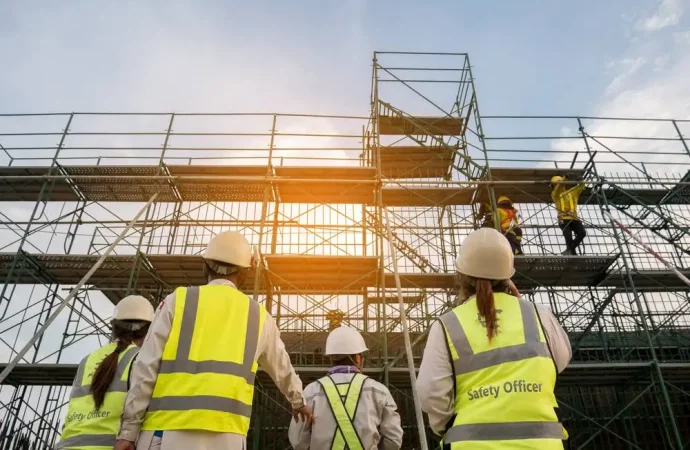Introduction NYC scaffolding is an essential part of the city’s skyline. From historic brownstones to towering skyscrapers, scaffolding structures are everywhere, keeping workers, pedestrians, and properties safe during construction, renovation, and repair. In a city that never stops building, scaffolding isn’t just useful—it’s legally required. Whether you’re a contractor, property owner, or developer, understanding the
Introduction
NYC scaffolding is an essential part of the city’s skyline. From historic brownstones to towering skyscrapers, scaffolding structures are everywhere, keeping workers, pedestrians, and properties safe during construction, renovation, and repair. In a city that never stops building, scaffolding isn’t just useful—it’s legally required. Whether you’re a contractor, property owner, or developer, understanding the importance of professional NYC scaffolding services can make or break your project’s timeline and safety compliance.
Why Scaffolding Is Vital in NYC
Scaffolding provides temporary support for workers and tools while construction or maintenance is underway. In NYC, it also serves another critical role: protecting the public. With thousands of buildings constantly undergoing repairs, the Department of Buildings (DOB) requires sidewalk sheds and scaffolding around structures over 40 feet when exterior work is being done. This ensures that debris, tools, or materials don’t fall and cause harm.
Because of these safety measures, NYC scaffolding isn’t just about construction—it’s about legal compliance, worker protection, and public responsibility.
Common Types of Scaffolding Used in NYC
There are several types of scaffolding commonly seen across New York City, including:
- Supported Scaffolding: The most traditional type, used for exterior work on mid- and high-rise buildings.
- Suspended Scaffolding: Often used by window washers and façade repair crews; it hangs from the roof and moves vertically.
- Pipe and Frame Scaffolding: Easy to assemble and popular for residential or low-rise projects.
- Sidewalk Sheds: Required in areas with pedestrian traffic, these protect the public from falling debris and materials.
Each type must be installed correctly by licensed professionals following DOB and OSHA regulations.
NYC Scaffolding Regulations and Permits
Before erecting scaffolding in NYC, a work permit must be filed and approved through the Department of Buildings. Contractors must be licensed and insured, and the structure must be inspected regularly.
Key regulations include:
- Permit for sidewalk sheds and supported scaffolding
- Inspection every six months
- Proper signage displayed on scaffolding
- Lighting under sidewalk sheds
Failure to follow these rules can result in heavy fines and stop-work orders. That’s why working with an experienced NYC scaffolding provider is essential.
Choosing a Reliable NYC Scaffolding Company
Not all scaffolding companies are created equal. When selecting a provider in NYC, consider the following:
- Licensing & Insurance: Make sure the company is DOB-approved and OSHA-compliant.
- Experience in NYC Projects: Choose providers who are familiar with navigating local regulations and permitting.
- Custom Scaffolding Solutions: Each building is different; choose a company that offers tailored support systems.
- Maintenance & Emergency Services: Look for companies that offer routine maintenance and 24/7 emergency response.
A reliable scaffolding partner helps avoid costly delays and ensures every aspect of the project remains compliant.
Scaffolding for Residential vs. Commercial Projects
In NYC, scaffolding isn’t limited to high-rise towers. It’s also used for:
- Brownstone and townhouse renovations
- Small retail storefront repairs
- Commercial façade restorations
- Public infrastructure upgrades (schools, hospitals, etc.)
Different project types require different scaffolding solutions. Residential projects may need low-rise, lightweight systems with less sidewalk impact, while commercial projects often require heavier, large-scale platforms and longer permitting processes.
The Importance of Safety in NYC Scaffolding
Safety is a top priority for any scaffolding project. According to the NYC DOB, improperly installed or poorly maintained scaffolding has caused accidents that could have been prevented. That’s why certified installers, proper harness use, fall protection systems, and structural inspections are required.
When you hire a professional NYC scaffolding company, you’re investing in safety for your workers, your project, and the public.
NYC Scaffolding and the Future of Construction
With Local Law 11 requiring façade inspections for buildings taller than six stories, scaffolding demand in NYC continues to rise. As aging infrastructure requires maintenance and more developers push for greener, taller, and safer buildings, the role of scaffolding will remain critical.
Innovations in modular scaffolding, eco-friendly materials, and smart safety monitoring systems are changing the way NYC scaffolding companies operate—making the process safer and more efficient than ever before.
NYC scaffolding is a critical component in ensuring the safety of construction sites across the city. With constant renovation, repairs, and new developments, scaffolding helps protect both workers and pedestrians. Properly installed scaffolding supports high-rise work, meets local building codes, and minimizes risks. From residential buildings to commercial towers, professional NYC scaffolding services offer secure, stable platforms that keep every project safe, compliant, and on schedule.
Conclusion
NYC scaffolding is more than a temporary structure— foundational part of construction and city life. From safety and compliance speed and functionality, choosing the right scaffolding service provider in NYC can save time, reduce risk, and ensure your project stays on track.From residential buildings to commercial towers, professional NYC scaffolding services offer secure, stable platform.
Whether you’re managing commercial tower or restoring landmark brownstone, scaffolding will be part of your journey—and understanding it is key to doing things.
















